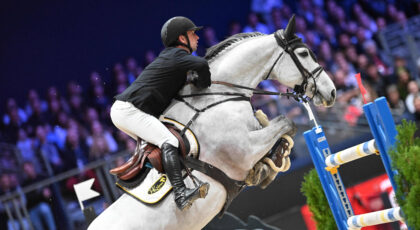Sitting trot is a major milestone in your development as a rider. It is a demonstration of your independent seat and it will allow you to ride in harmony with your horse using subtle and soft aids. Here dressage trainer Amelia Newcomb explains one aspect of preparing both you and your horse to sit the trot: getting your horse in front of the leg.
***
If your horse slows down when you sit the trot, he is not in front of the leg.
In front of the leg means that if you ask your horse to go forward, he does so willingly and without hesitation. He maintains the same rhythm and tempo, without constant reminders.
It is essential that your horse is in front of the leg before you start to sit the trot. If you are constantly squeezing and cueing your horse to go forward, it will stiffen your seat and back and make the sitting trot difficult.
It’s also physically draining for the rider—you shouldn’t be working harder than your horse!
The big secret to the sitting trot is that the more correctly your horse is using their body and topline, the easier it is to sit the trot! The most common mistake I see is riders sitting the trot too soon, before their horse is using their body correctly.
Here we’ll discuss two exercises I use to teach horses to be in front of your leg in preparation to sit trot.

Important: Do not worry about your horse’s head during these exercises. We are purely focused on the driving aids here and asking for contact or roundness could be misconstrued as an aid to slow down or stop! Let the energy flow forwards for the purpose of increasing their sensitivity to the aids. The contact can come once the forwardness has returned!
Exercise #1: Re-sensitize your horse to the leg
Horses are not naturally lazy. We often train them to be lazy so that they don’t over react and leave us in the dirt! But with correct training, we can re-establish forwardness.
Rider position is crucial for waking up a lazy horse. You need to be in the optimum position to give effective aids with the minimum energy expenditure from you. So be sure you are sitting correctly in the saddle. (For more on that, check out my article “The Single Most Important Thing You Can Do to Improve Your Riding.”)
Equally important is effectively using your aids. The driving aids mean GO. Your legs are your primary driving aid and your whip is an auxiliary aid used to reinforce the legs.
This may sound counterintuitive, but you need to keep your legs off a lazy horse, so that when you do apply leg, you get a reaction. If your leg is always on, it loses meaning for the horse—they become desensitized to it. (The reverse is true for a hot horse, your legs should always a little on so that they become less sensitive to them!)
A game I like to play with a lazy horse is a leg re-sensitizing exercise.

Here’s how it works:
Step 1: Walk on a loose rein, then close the legs and ask for trot.
Start with a light squeeze or taps with your heels and increase the intensity until the horse reacts. The second he picks up the trot, take the leg off and release the pressure!
Let the horse trot for a few strides, then slowly come back to the walk.
At the walk, practice letting the him walk with a neutral leg. Your heels should be down and the leg should drape gently against their side without exerting pressure.
Repeat the exercise, focusing on that simple reaction to the leg.
Note: This same pattern of cues can be used to re-sensitize a horse to the whip. Remember horses can feel a fly land on a single hair, so they can feel the slightest tickle from your whip, and that’s all they should need to get a reaction.
Step 2: Practice walk-trot-walk transitions.
Now that the horse is cued to respond to the leg, work on getting a consistent response with walk-trot-walk transitions.
We want the upward transition to be abrupt and explosive. We want the downward transition to be gradual, bringing your horse down to an ACTIVE walk without letting them stop.
Repeat.
Remember: when working with lazy horses, reward by release! As soon as the horse responds to the given aid, put your heels down and take your leg off.
You’ll notice in a short space of repeating these transitions that your horse’s sensitivity to the aids will improve!
Before you go on to the second exercise, watch this video where I go into more detail with Kensington.
Exercise #2: Get your horse on cruise control
Once you’ve established consistent responsiveness to the leg, the next step is to get the horse to stay in front of the leg without “nagging” them.
It is easy to get lulled into the habit of supporting your horse with the leg all the time and then find yourself kicking and clucking every stride without getting a response! This becomes a big problem when you need to move up in line or on a rollback or you need to ride a half pass or tempi changes and you don’t get the response you need when you ask for it!
This next exercise focuses on keeping the horse in front of the leg. I like to think of it as having cruise control in your car. You want to be able to set your horse at a certain speed—for example, a 4 mph trot—and they should stay at that trot until you hit the brakes or the gas pedal.
Here’s how it works:
Step 1: Establish the pace you want from your horse at the trot.
Step 2: Now, put your heels down, take your leg off, but stay following the motion with your seat.
Step 3: When your horse slows down without you asking, the correction is that they have to go EVEN FASTER than you originally wanted them to go. For example, if you want your horse to trot at 4 mph and they slow down to 3.5 mph, push them up to 6 mph for half a lap. The consequence for them slowing down is to go faster!
Step 4: Correct quickly and consistently.
Notice where in the arena your horse tends to slow down. Many horses slow down when they are headed away from the gate. The instant he slows down, make the correction quickly and consistently.
If your horse makes the mistake of going too fast when you correct them—if they canter off when you wanted trot, for instance—allow them continue forward for a bit. Don’t punish them by bring them back right away. If they make the “mistake” of going too forward, this is a good thing!
Step 5: Be sure you have independent aids.
When you correct your horse with your legs, you must NOT pull back with your reins and your seat must stay with the forward motion of your horse.
Watch this video for a detailed demonstration of this exercise:
In the end, you want your horse to be a self-going horse. This is going to be a process if you horse has gotten used to you nagging constantly! You want to use “reminding” aids to keep your horse going forward rather than “supporting” aids.
Want to learn more about preparing both you and your horse for the sitting trot? Download my FREE PDF: 5 Exercises to Do Before Sitting the Trot!





 April 4, 2024
April 4, 2024 




























